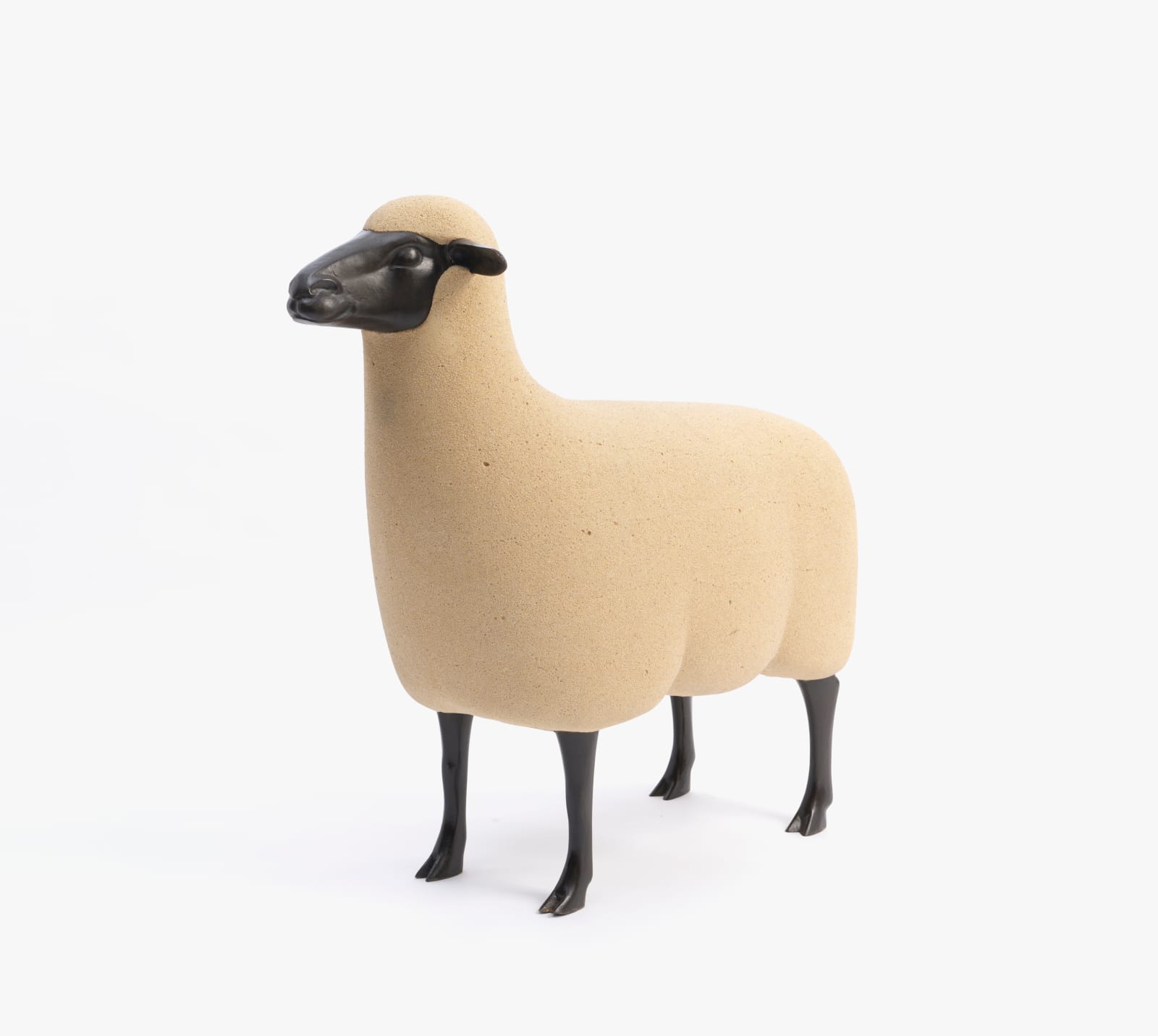

François-Xavier Lalanne French, 1927-2008
Mouton de Pierre Classique, 1977/1990
Epoxystone and bronze
87 x 92.7 x 40.6 cm. (34 1/4 x 36 1/2 x 16 in.)
Edition of 250 (#162/250)
Copyright The Artist
François-Xavier Lalanne’s Mouton series holds a distinctive place in post-war sculpture. Conceived in the mid-1960s, it began with the Mouton de Laine, first presented in 1965 at the Salon de...
François-Xavier Lalanne’s Mouton series holds a distinctive place in post-war sculpture. Conceived in the mid-1960s, it began with the Mouton de Laine, first presented in 1965 at the Salon de la Jeune Peinture under the evocative title Pour Polytheme. The name alludes to Homer’s Odyssey, recalling the episode in which Ulysses and his companions escape the Cyclops Polyphemus by clinging to the bellies of giant sheep.
The installation featured twenty-four sheep – eight standing and sixteen grazing – playfully arranged across the gallery floor. Positioned at the entrance, the sculptures quickly became a sensation, with artists and critics photographed reclining among them.
By 1967, the Moutons de Laine appeared in Life magazine, featured in chic Parisian interiors and collected by leading cultural figures, including Yves Saint Laurent. The series followed Lalanne’s first private commission for Saint Laurent and Pierre Bergé in 1965 – the Bar YSL. Reflecting on the Moutons de Laine, Lalanne remarked: “I thought that it would be funny to invade that big living room with a flock of sheep. It is, after all, easier to have a sculpture in an apartment than to have a real sheep. And it’s even better if you can sit on it.”
In 1977, Lalanne introduced the Moutons de Pierre Classique, reimagining his earlier design in epoxy stone. This version replaced the woolly surfaces with a more monumental and weather-resistant form, suitable for outdoor settings as well as indoor.
He further developed the concept in 1988 with Moutons Transhumant. Inspired by the Verdon Gorge and southern French breeds, these works featured a distinctive bronze finish on the head, echoing the sunlit tones of the region’s sheep. Leaner in form, they evoke the ancient pastoral practice of transhumance – the seasonal movement of flocks in search of new pastures.
In the 1990s, Lalanne unveiled the Nouveaux Moutons, comprising the Brebis (1994), Bélier (1994), and Agneau (1996). Subtle details, such as stone accents around the ears, introduced a refined elegance to their minimalist forms.
Today, Lalanne’s Moutons are regarded as icons of 20th-century design. Coveted by collectors, designers, and art connoisseurs, they have graced the interiors and collections of Yves Saint Laurent, Tom Ford, Peter Marino, Karl Lagerfeld, and Hubert de Givenchy. Their enduring appeal lies in their balance of humour and sophistication – artworks that double as functional, inviting objects.
The lasting success of the Mouton series highlights Lalanne’s genius in bridging art and life. More than ornamental sculptures, these works invite touch, interaction, and delight. They transform how art is experienced and how furniture is perceived – as sculpture to be inhabited, and as design to be contemplated.
The installation featured twenty-four sheep – eight standing and sixteen grazing – playfully arranged across the gallery floor. Positioned at the entrance, the sculptures quickly became a sensation, with artists and critics photographed reclining among them.
By 1967, the Moutons de Laine appeared in Life magazine, featured in chic Parisian interiors and collected by leading cultural figures, including Yves Saint Laurent. The series followed Lalanne’s first private commission for Saint Laurent and Pierre Bergé in 1965 – the Bar YSL. Reflecting on the Moutons de Laine, Lalanne remarked: “I thought that it would be funny to invade that big living room with a flock of sheep. It is, after all, easier to have a sculpture in an apartment than to have a real sheep. And it’s even better if you can sit on it.”
In 1977, Lalanne introduced the Moutons de Pierre Classique, reimagining his earlier design in epoxy stone. This version replaced the woolly surfaces with a more monumental and weather-resistant form, suitable for outdoor settings as well as indoor.
He further developed the concept in 1988 with Moutons Transhumant. Inspired by the Verdon Gorge and southern French breeds, these works featured a distinctive bronze finish on the head, echoing the sunlit tones of the region’s sheep. Leaner in form, they evoke the ancient pastoral practice of transhumance – the seasonal movement of flocks in search of new pastures.
In the 1990s, Lalanne unveiled the Nouveaux Moutons, comprising the Brebis (1994), Bélier (1994), and Agneau (1996). Subtle details, such as stone accents around the ears, introduced a refined elegance to their minimalist forms.
Today, Lalanne’s Moutons are regarded as icons of 20th-century design. Coveted by collectors, designers, and art connoisseurs, they have graced the interiors and collections of Yves Saint Laurent, Tom Ford, Peter Marino, Karl Lagerfeld, and Hubert de Givenchy. Their enduring appeal lies in their balance of humour and sophistication – artworks that double as functional, inviting objects.
The lasting success of the Mouton series highlights Lalanne’s genius in bridging art and life. More than ornamental sculptures, these works invite touch, interaction, and delight. They transform how art is experienced and how furniture is perceived – as sculpture to be inhabited, and as design to be contemplated.

